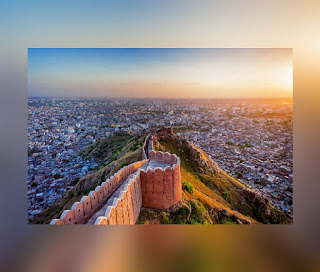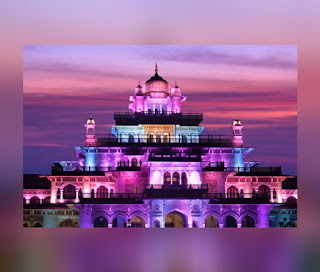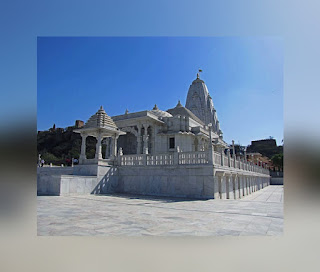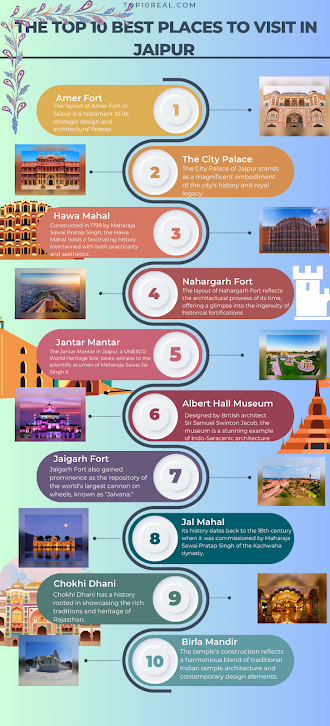Welcome to Jaipur, the "Pink City" of India! This enchanting city in the northwestern state of Rajasthan is a treasure trove of history, culture, and architectural wonders. From the moment you arrive, you'll be swept away by the vibrant energy and deep sense of tradition that permeates every corner of this magnificent city.
🎯Table of Content
- 1. Amer Fort
- 2. The City Palace
- 3. Hawa Mahal
- 4. Nahargarh fort
- 5. Jantar Mantar
- 6. Albert Hall Museum
- 7. Jaigarh Fort
- 8. Jal Mahal
- 9. Chokhi Dhani
- 10. Birla Mandir
- 11. INFOGRAPHIC
One of the first things you'll notice about Jaipur is its stunning architecture. The city's terracotta-pink hue is a sight to behold, and it's no wonder that Jaipur is known as the "Pink City." This unique colour, which was introduced in the late 19th century, is a symbol of the city's warmth and hospitality. Everywhere you look, you'll see buildings painted in this elegant shade, creating a harmonious and picturesque cityscape.
But Jaipur is much more than just a pretty face. This city is steeped in history and tradition, and every destination on our list offers a unique glimpse into its captivating past. Whether you're exploring the magnificent Amber Fort, or marvelling at the intricate details of the Hawa Mahal, you'll be transported to a different time and place.
Of course, there are countless other breathtaking places to discover in Jaipur, and we've only scratched the surface. If you have any suggestions for places that should be added to our list, please let us know in the comments.
Scroll down, to learn about "The Top 10 Best Places to Visit in Jaipur".
1. Amer Fort
History
The Amer Fort is a remarkable testament to the rich history of India, dating back to the late 16th century. Its founder, Raja Man Singh I, demonstrated exceptional strategic foresight and architectural brilliance in its construction. The fort's elevated location atop the Aravalli hills near Amer town provided a strategic advantage for defence and control over the region. The Kachwaha dynasty's successive rulers expanded and embellished the fort, resulting in a stunning fusion of Rajput and Mughal architectural styles. Amer Fort has withstood the test of time, surviving the British colonial era and evolving into a UNESCO World Heritage Site. Its captivating journey through history is truly awe-inspiring.
Layout
Experience the architectural brilliance of Amer Fort, which is a true testament to strategic design and finesse. Perched majestically atop a hill, the fort's layout seamlessly blends functionality and aesthetic appeal, with courtyards, palaces, and defensive structures. Enter through imposing gates like the Suraj Pol and Chand Pol, revealing intricate artwork and symbolic significance. Encounter audience halls displaying remarkable marble work and latticework, and the elegant chambers of the Zenana Mahal. The centrepiece, Sheesh Mahal, or the "Palace of Mirrors," showcases an enchanting display of glasswork that creates a magical effect when illuminated. Unravel the fort's history and experience its beauty as you explore its courtyards, ramparts, and chambers.
Things to explore:-
Here are some of the things to do in Amer Fort:
1. Sheesh Mahal: The Sheesh Mahal, also known as the "Palace of Mirrors," is an absolute must-see at the fort, boasting thousands of tiny mirrors that create a truly mesmerizing effect.
2. Elephant Rides: For a truly unique and adventurous experience, take an elephant ride to the fort entrance and add an extra touch of charm to your visit.
3. Diwan-e-aam and Diwan-e-Khas: Step into the grand public and private audience halls and marvel at the opulence of the royal court.
4. Panoramic Views: The fort offers breathtaking panoramic views of the stunning Aravalli hills and Maota Lake, making it a paradise for photographers.
5. Gardens and Courtyards: Take a stroll through the beautiful gardens and courtyards, including the Sukh Niwas and Jas Mandir, and find a serene spot to relax and unwind.
Rank
Amer Fort ranks at the top in terms of the best places to visit in Jaipur.
2. The City Palace
History
The City Palace of Jaipur stands as a magnificent embodiment of the city's history and royal legacy. Constructed in the 18th century by Maharaja Sawai Jai Singh II, the founder of Jaipur, the palace showcases a harmonious blend of Rajput, Mughal, and European architectural styles. It served as the seat of the ruling Kachwaha dynasty and evolved over the years with successive rulers adding their own contributions. The palace complex includes a series of courtyards, gardens, palaces, and museums, each reflecting a distinct era and purpose. The City Palace holds not only architectural marvels but also historicartefactscts, paintings, and relics that offer a glimpse into the opulent lifestyle and cultural heritage of Rajasthan's royalty.
Layout
Its captivating and intricate layout is a harmonious blend of Rajput, Mughal, and European architectural styles, showcasing the grandeur of a bygone era. The palace complex is a maze of courtyards, gardens, and interconnected buildings, each exuding its unique charm. The Chandra Mahal (Moon Palace) and Mubarak Mahal (Welcome Palace) are just two of the many sections that serve different purposes and display distinct architectural elements. The ornate gateways, vibrant frescoes, and beautifully adorned pillars are a testament to the artisans' skill and attention to detail.
Things to explore:-
The City Palace is not only a historic gem but also a living testament to Jaipur's rich legacy, making it a must-visit destination for history enthusiasts, art lovers, and travellers seeking a royal experience. Here aof the things that you must explore here:-
1. Weaponry Exhibit: Behold a stunning collection of historic weapons, featuring swords, daggers, and firearms.
2. Chandra Mahal: A magnificent seven-story palace boasting exquisite architecture and awe-inspiring views of the city.
3. Chandra Mahal: A majestic seven-story palace showcasing unparalleled architecture and breathtaking vistas of the surrounding metropolis.
4. Pritam Niwas Chowk: Four distinct gateways dedicated to the four seasons, each adorned with unique motifs and designs.
5. Artistic Details: Lavish marble carvings, intricate frescoes, and ornate embellishments grace the palace's walls and courtyards.
6. Textile Gallery: Uncover a lavish assortment of royal textiles, featuring intricate embroideries and tapestries of unparalleled beauty.
Rank
The City Palace ranks second in terms of the best places to visit in Jaipur.
3. Hawa Mahal
History
The Hawa Mahal, or "Palace of Winds," is a truly enchanting architectural masterpiecBuilt-in in 1799 by Maharaja Sawai Pratap Singh, this stunning palace boasts a rich history that blends both practicality and beauty. Its intricate façade, adorned with countless jharokhas (small windows), was thoughtfully designed to allow royal women to observe the bustling street life while remaining hidden from view, reflecting the customs and traditions of the time. The unique five-story structure, resembling a honeycomb or beehive, served as a ventilation system to keep the palace cool during the sweltering Rajasthan summers.
Layout
Its five-storey façade, intricately designed to resemble the crown of Lord Krishna, is a sight to behold. This iconic structure, an extension of the City Palace, bts of 953 small windows, or "jharokhas," meticulously carved and arranged in a honeycomb pattern. These windows not only provide ventilation and airflow to the palace but also offer the royal women a discreet vantage point to observe processions and festivities on the streets below, ensuring their privacy. The Hawa Mahal is a testament to the architectural ingenuity of the past, capturing the essence of both form and function in a visually stunning manner.
Things to explore:-
Here are some of theallowableorable things in the Hawa Mahal:-
1. Architectural Splendor: The Hawa Mahal boasts a unique five-story facade adorned with intricate latticework and ornate windows, showcasing the distinctive Rajput architectural style and making it a visual delight.
2. Latticed Windows and Breezy Architecture: The Hawa Mahal's design was intended to allow royal women to observe street processions and daily life without being seen. The latticed windows also ensured natural ventilation, giving rise to its name, "Palace of Winds."
3. Photography Paradise: The Hawa Mahal's intricate architecture and symmetrical patterns make it a photographer's dream, offering countless opportunities for capturing stunning shots.
4. Panoramic Views: The upper floors of the Hawa Mahal offer panoramic views of the bustling streets below and the city's landmarks, providing a unique perspective on Jaipur's urban landscape.
5. Aesthetic Elegance: The Hawa Mahal's delicate pink sandstone facade and harmonious integration with the surrounding buildings create an aesthetic masterpiece that exemplifies the artistic vision of its creators.
Rank
Hawa Mahal ranks third in terms of the best places to visit in Jaipur.
4. Nahargarh fort
History
Nahargarh Fort, situated atop the rugged Aravalli hills and overlooking the Pink City of Jaipur, boasts a rich history steeped in strategic defence and royal legacy. Constructed in 1734 by Maharaja Sawai Jai Singh II, the founder of Jaipur, the fort served as a retreat and defence post. Its name, "Nahargarh," meaning "Abode of Tigers," reflects the belief that supernatural obstacles hindered its construction due to the restless spirit of a slain prince named Nahar Singh Bhomia. The fort's walls and bastions have witnessed the changing times and the rich history of Jaipur. Today, Nahargarh Fort stands as a symbol of architectural finesse and the courage of its builders, offering visitors a glimpse into the past and breathtaking views of Jaipur's urban sprawl against the backdrop of the Aravalli hills.
Layout
Nahargarh Fort stands as a true testament to the pinnacle of architectural finesse, seamlessly blending practicality with artistic elegance. Its strategic layout comprises a series of interconnected courtyards, chambers, and walls, which not only provide formidable defensive capabilities but also exude an unparalleled aesthetic charm. The fort's grandeur is further accentuated by its imposing main gate, the opulent Madhavendra Bhawan palace area, replete with multiple suites for the royal family, and watchtowers that offer spellbinding vistas.
Things to explore:-
Here are some of the best things that you can explore in Nahargarh Fort:-
1. Ramparts: Take a stroll along the ramparts of the fort for an unparalleled viewpoint.
2. Walled Enclosure: Venture into the walled enclosure of the fort for an immersive experience.
3. Nahargarh Biological Park: Discover the neighbouring Nahargarh Biological Park and all its wonders.
4. Madhavendra Palace: Experience the exquisitely crafted Madhavendra Palace and its intricate designs.
Rank
Nahargarh Fort ranks fourth in terms of the best places to visit in Jaipur.
5. Jantar Mantar
History
The Jantar Mantar in Jaipur, a UNESCO World Heritage Site, is a remarkable testament to the scientific acumen of Maharaja Sawai Jai Singh II. Constructed in the early 18th century, this observatory is a living legacy of Jai Singh's passion for astronomy and his dedication to advancing the study of celestial phenomena. The Jantar Mantar's blend of architectural precision and mathematical sophistication is truly awe-inspiring, and its array of intriguing instruments used for observing celestial bodies and measuring time with astonishing accuracy is a testament to Jai Singh's pursuit of knowledge and his contribution to the world of astronomy.
Layout
The layout of Jantar Mantar is a precise and intricate arrangement of large, unique instruments designed for celestial calculations. Spread across a spacious area, each instrument serves a specific purpose, allowing astronomers of the past to measure time, track planetary movements, and study celestial phenomena with astonishing accuracy. The geometric precision and strategic positioning of these instruments reflect the profound understanding of astronomy during the time of its construction in the 18th century. Visitors today can explore this open-air observatory, marvel at the ingenuity of its design, and gain insights into the scientific prowess of the Indian astronomers of the past.
Things to explore:-
Here are some of the remarkable instruments that you should surely explore here:-
1. Samrat Yantra: The world's largest sundial, towering over all others.
2. Jai Prakash Yantra: A celestial globe designed to study the positions of the stars and planets.
3. Misra Yantra: A multifaceted instrument used for a variety of astronomical measurements.
4. Rashivalaya Yantra: A massive circular device used for observing the zodiac.
5. Dhruva Yantra: A tool that aids in locating the North Star, crucial for navigation and orientation.
Rank
Jantar Mantar ranks fifth in terms of the best places to visit in Jaipur.
6. Albert Hall Museum
History
Step into the Albert Hall Museum in Jaipur, Rajasthan, and you'll be transported back in time to a world where art, architecture, and cultural heritage intertwine. This magnificent museum was built in the 19th Century to commemorate the visit of Prince Albert, the consort of Queen Victoria, and is a masterpiece of Indo-Saracenic architecture. Designed by British architect Sir Samuel Swinton Jacob, it seamlessly blends Indian and European styles. The museum showcases a diverse range of exhibits spanning art, history, and anthropology, making it an instrumental institution for preserving and showcasing Rajasthan's cultural richness.
Layout
The Albert Hall Museum in Jaipur is a true masterpiece of architecture, blending Indo-Saracenic and European styles in a captivating way. The central dome, surrounded by smaller domes and turrets, is breathtaking and gives the museum a palatial feel. The courtyards, galleries, and corridors provide a seamless flow for visitors to explore the extensive collection of artefacts. The stonework and lattice patterns on the facade are exquisite and add to the museum's visual allure. Visitors step inside and are transported to a world of Rajasthan's rich history, art, and culture. The layout of the Albert Hall Museum enhances the overall experience of immersing oneself in the treasure trove of historical artefacts and artistic marvels it holds within its walls.
Things to explore:-
Albert Hall is full of impressive things, here are some of them:-
1. Textile Gallery: Behold the splendour of traditional Indian textiles and clothing.
2. Arms and Armour Gallery: Immerse yourself in a vast collection of weaponry and armor on display.
3. Jewelry: Marvel at the breathtaking assortment of traditional Indian jewellery, a true feast for the eyes.
4. Photography Section: Delve into the past with a captivating collection of vintage photographs showcasing the beauty of Rajasthan.
Rank
Albert Hall Museum ranks sixth in terms of the best places to visit in Jaipur.
7. Jaigarh Fort
History
The Jaigarh Fort, a bastion of history and grandeur, is inextricably linked to the strategic and defensive considerations of the region. Commissioned in 1726 by the illustrious Maharaja Sawai Jai Singh II, this magnificent fortress was crafted with an unwavering focus on defence. Its commanding hilltop position, overlooking the majestic Amber Fort and the tranquil Maota Lake, provided an unparalleled vantage point for vigilant surveillance of the surroundings. The fort's awe-inspiring walls, watchtowers, and artillery points bear witness to its military significance. The Jaigarh Fort's legacy is defined by its pivotal role in safeguarding the Amber and Jaipur region and its status as a crucial link in the region's defence network.
Layout
The Jaigarh Fort, a true marvel of architectural prowess, stands tall and proud atop a rugged hill, exuding an air of grandeur and magnificence. Its imposing walls, watchtowers, and intricate design are a testament to the strategic vision of its builders, who crafted it with utmost care and precision. From its lofty perch, the fort offers breathtaking panoramic views of the surrounding landscape, making it an ideal vantage point for observing the city below. The fort's formidable fortifications, including the monumental cannon "Jaivana," bear witness to its historical significance as a military stronghold. The interplay of courtyards, palatial structures, and military installations within the fort showcases its dual roles as a residence for royalty and a bastion of military might.
Things to explore:-
Here are some of the remarkable things to explore in Jaigarh Fort:-
1. Charbagh Garden: Unwind in the stunning four-part garden.
2. Canon Foundry: Educate yourself on the historical process of cannon production.
3. Rani Mahal: Unveil the palace of the Queen, adorned with intricate designs.
4. Sagar Talav (Moat): Witness the ancient water reservoir encircling the fort.
5. Armory: Behold a captivating assortment of antique weaponry and armour
Rank
Jaigarh Fort ranks seventh in terms of the best places to visit in Jaipur.
8. Jal Mahal
History
Jal Mahal, is a mesmerizing architectural masterpiece nestled amidst the idyllic Man Sagar Lake. This opulent palace, commissioned by the illustrious Maharaja Sawai Pratap Singh of the Kachwaha dynasty in the 18th century, was designed as a summer haven and hunting lodge for the royal family. The palace's strategic location allowed the royals to bask in the serene ambiambience the refreshing waters of the lake during the scorching Rajasthani summers. The Jal Mahal's unique structure, with the first four stories submerged in water, while the fifth story offers a surreal vista. This architectural marvel has undergone meticulous restoration to preserve its intricate beauty, serving as a testament to the artistic finesse of the past and an iconic symbol of Jaipur's architectural heritage.
Layout
The Jal Mahal is a true masterpiece of architectural brilliance and a testament to the harmonious relationship between man and nature. This palace exudes an aura of unparalleled luxury and sophistication. Its five floors, partially submerged in the tranquil waters, are a sight to behold, with only the top floor visible above the waterline. The intricate arched openings, ornate balconies, and delicate lattice work, all reflect the opulent Rajput and Mughal architectural styles. The palace's strategic location amidst the lake offers a panoramic view of the majestic Aravalli hills and the bustling cityscape, making it a true gem of regal grandeur.
Things to explore:-
Don't forget to check out these awesome things in the Jal Mahal:-
1. Evening Illumination: Behold the palace aglow with stunning illumination at nightfall.
2. Local Culture: Engage with the locals and delve into their customs and heritage.
3. Peaceful Retreat: Seek solace in Jal Mahal, a tranquil haven away from the city's hustle and bustle.
4. Bird Watching: Observe a plethora of avian species that call the lake their home.
5. Mystical Ambiance: Embrace the enigmatic aura of the palace partially submerged in water.
Rank
Jal Mahal ranks rankth in terms of the best places to visit in Jaipur.
9. Chokhi Dhani
History
Chokhi Dhani, a cultural village resort situated in the heart of Jaipur, is a magnificent destination that embodies the rich traditions and heritage of this majestic land. In 1989, the visionary Rajasthani entrepreneur, Gul Vaswani, conceptualized Chokhi Dhani to provide visitors with an authentic and immersive experience of the state's vibrant culture and hospitality. The name "Chokhi Dhani" translates to "Fine Hamlet" in English, and this luxurious resort truly lives up to its name, offering a perfect blend of rustic charm, traditional architecture, mesmerizing folk performances, and mouth-watering Rajasthani cuisine. A renowned destination that celebrates the artistry, warmth, and traditions of Rajasthan, Chokhi Dhani promises an unforgettable journey into the heart of this culturally rich region.
Layout
At Chokhi Dhani, guests are transported to a world of authentic Rajasthani culture and tradition. The resort's captivating layout, reminiscent of a traditional rural village, showcases the vibrant heritage and lifestyle of Rajasthan. As visitors wander through the meandering pathways, they are greeted by charming huts, artisan stalls, and rustic courtyards, all beautifully capturing the essence of a bygone era. The intricate carvings, hand-painted walls, and ethnic decor elements add to the enchanting atmosphere. The central courtyard comes alive with cultural performances, folk dances, and music, immersing guests in the local culture. The dining area, styled as an ethnic Rajasthani bazaar, offers a chance to savour the region's delectable cuisine. Chokhi Dhani's layout truly celebrates the state's rich heritage, providing an enchanting experience that will stay with guests forever.
Things to explore:-
Here are some of the most remarkable things to explore in Chokhi Dhani:-
1. Cultural Performances: Immerse yourself in the vibrant Rajasthani culture through live performances of traditional folk dances and music.
2. Rajasthani Village Setup: Step back in time and experience the charm of a recreated Rajasthani village.
3. Bonfire: Gather around a cosy bonfire and share stories with your loved ones, creating unforgettable memories.
4. Puppet Shows: Be captivated by the colourful puppet shows that showcase local tales and legends.
5. Camel Rides: Embark on a quintessential Rajasthani adventure and take a camel ride, enjoying the stunning scenery along the way.
Rank
Chokhi Dhani ranks ninth in terms of the best places to visit in Jaipur.
10. Birla Mandir
History
The Birla Mandir, also known as the Lakshmi Narayan Temple, is a significant landmark in Jaipur's history. Constructed in the early 1980s by the Birla family, this modern temple is dedicated to Lord Vishnu and Goddess Lakshmi, the deities of wealth and prosperity. The temple's architecture is a harmonious blend of traditional Indian temple design and contemporary elements. It stands as a testament to the Birla family's devotion to their faith and their commitment to contributing to Jaipur's cultural and religious landscape. The Birla Mandir has become a spiritual haven for both locals and tourists, offering a serene atmosphere amidst the bustling city.
Layout
The intricate carvings and towering spire of the Nagara style are breathtaking, and the attention to detail is evident in every aspect of the temple. As you enter the complex, you are greeted by the beauty of the exterior walls and the meticulously crafted pillars. The sanctum sanctorum is a true masterpiece, with exquisite marble sculptures and beautifully crafted idols. The inner sanctum radiates a sense of peace and tranquillity, inviting devotees to offer their prayers and find solace. The symmetrical layout creates a serene atmosphere for spiritual contemplation and reflection.
Things to explore:-
Birla Mandir in Jaipur is a revered site of worship and a testament to architectural splendour and cultural significance. Don't miss out on these remarkable things if you ever visit here:-
1. Laxmi Narayan Temple: Pay homage to Lord Vishnu and Goddess Laxmi at the main deity shrine.
2. Birla Mandir Exterior: Marvel at the exquisite white marble architecture of the temple.
3. Evening Aarti: Attend the evening aarti (prayer ceremony) for a profound spiritual encounter.
4. Temple Lighting: Observe the temple's stunning illumination at night.
5. Devotional Music: Enjoy the soulful devotional music played during prayer ceremonies.
Rank
Birla Mandir ranks tenth in terms of the best places to visit in Jaipur.














0 Comments